 Back to Archaeological Sites
Back to Archaeological Sites
 Back to the review of hominins
Back to the review of hominins
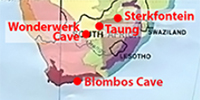 Hominid sites in Africa, including Homo sapiens
Hominid sites in Africa, including Homo sapiens
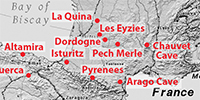 Hominid sites in Europe, including Homo sapiens
Hominid sites in Europe, including Homo sapiens
Hominids before Homo sapiens
Hominids or Hominins?
The most commonly used recent definitions are:
Hominid – the group consisting of all modern and extinct Great Apes (that is, modern humans, chimpanzees, gorillas and orang-utans plus all their immediate ancestors).
Hominin – the group consisting of modern humans, extinct human species and all our immediate ancestors (including members of the genera Homo, Australopithecus, Paranthropus and Ardipithecus).
Definition above: https://australianmuseum.net.au/
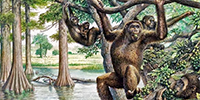 The swamp ape Oreopithecus bambolii was 120 cm tall and weighed 30 kg, with a brain capacity of up to 200 cm3 lived in swampy areas of what is now Italy, 10 to 8 million years ago. The long forelimbs are indicative of tree-dwelling. The ape went extinct after a land bridge connected their island to the mainland, allowing large saber-toothed cats and other predators to stalk the island.
The swamp ape Oreopithecus bambolii was 120 cm tall and weighed 30 kg, with a brain capacity of up to 200 cm3 lived in swampy areas of what is now Italy, 10 to 8 million years ago. The long forelimbs are indicative of tree-dwelling. The ape went extinct after a land bridge connected their island to the mainland, allowing large saber-toothed cats and other predators to stalk the island.
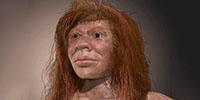 Of all the ancient peoples that have been studied by scientists, none has set puzzles quite so profound as those left behind by the Denisovans. Only a few tiny pieces of bone and teeth have ever been found of this long extinct species – fragmentary remains that would all fit snugly inside a cigarette packet. Yet these fossil scraps suggest that Denisovans had a considerable influence on people today. Up to 6% of the genes now found in modern New Guineans and 3-5% of the DNA of aboriginal Australians is made up of Denisovan DNA, scientists have discovered. The gene that allows Tibetan people to survive high altitudes is also believed to have been inherited from them.
Of all the ancient peoples that have been studied by scientists, none has set puzzles quite so profound as those left behind by the Denisovans. Only a few tiny pieces of bone and teeth have ever been found of this long extinct species – fragmentary remains that would all fit snugly inside a cigarette packet. Yet these fossil scraps suggest that Denisovans had a considerable influence on people today. Up to 6% of the genes now found in modern New Guineans and 3-5% of the DNA of aboriginal Australians is made up of Denisovan DNA, scientists have discovered. The gene that allows Tibetan people to survive high altitudes is also believed to have been inherited from them.
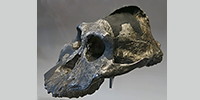 Australopithecus aethiopicus is in the group known as the robust australopithecines. The robust australopithecines are split into three species, Australopithecus aethiopicus, Australopithecus robustus, and Australopithecus boisei. There has been an ongoing debate over the exact phyletic origins of each of these species. The robust australopithecines share many characteristics of the cranium and mandible, perhaps suggesting a shared evolutionary development.
Australopithecus aethiopicus is in the group known as the robust australopithecines. The robust australopithecines are split into three species, Australopithecus aethiopicus, Australopithecus robustus, and Australopithecus boisei. There has been an ongoing debate over the exact phyletic origins of each of these species. The robust australopithecines share many characteristics of the cranium and mandible, perhaps suggesting a shared evolutionary development.
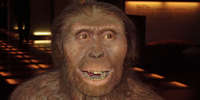 Lucy, Australopithecus afarensis, is an extinct hominid that lived between 3.9 and 2.9 million years ago. Australopithecus afarensis was slenderly built, like the younger Australopithecus africanus. It is thought that Australopithecus afarensis was more closely related to the genus Homo (which includes the modern human species Homo sapiens ), whether as a direct ancestor or a close relative of an unknown ancestor, than any other known primate from the same time.
Lucy, Australopithecus afarensis, is an extinct hominid that lived between 3.9 and 2.9 million years ago. Australopithecus afarensis was slenderly built, like the younger Australopithecus africanus. It is thought that Australopithecus afarensis was more closely related to the genus Homo (which includes the modern human species Homo sapiens ), whether as a direct ancestor or a close relative of an unknown ancestor, than any other known primate from the same time.
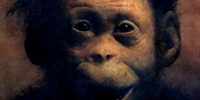
Lucy's baby, Australopithecus afarensis
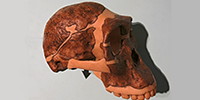
Australopithecus africanus
 Australopithecus boisei or Paranthropus boisei was an early hominin. It lived in Eastern Africa during the Pleistocene epoch from about 2.3 until about 1.2 million years ago. First discovered by anthropologist Mary Leakey in 1959, at Olduvai Gorge, Tanzania, the well-preserved cranium (nicknamed 'Nutcracker Man') was dated to 1.75 million years old and had characteristics distinctive of the robust australopithecines. The brain volume is quite small, about 500 cc, not much larger in comparison to Australopithecus afarensis and Australopithecus africanus, or modern day chimpanzees. It had a skull highly specialised for heavy chewing and several traits seen in modern day gorillas. It inhabited savannah woodland territories.
Australopithecus boisei or Paranthropus boisei was an early hominin. It lived in Eastern Africa during the Pleistocene epoch from about 2.3 until about 1.2 million years ago. First discovered by anthropologist Mary Leakey in 1959, at Olduvai Gorge, Tanzania, the well-preserved cranium (nicknamed 'Nutcracker Man') was dated to 1.75 million years old and had characteristics distinctive of the robust australopithecines. The brain volume is quite small, about 500 cc, not much larger in comparison to Australopithecus afarensis and Australopithecus africanus, or modern day chimpanzees. It had a skull highly specialised for heavy chewing and several traits seen in modern day gorillas. It inhabited savannah woodland territories.
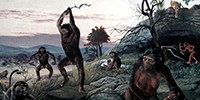
Australopithecus robustus / Paranthropus robustus
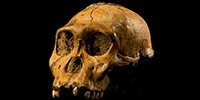
Australopithecus sediba
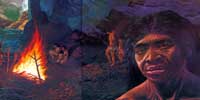
Homo erectus (Beijing Man, Peking Man) sites
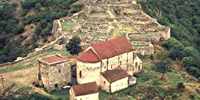
The Homo Erectus site at Dmanisi
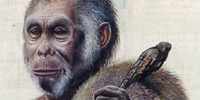 Homo floresiensis was a one metre tall, human-like creature living and using tools in Indonesia just 18 000 years ago and was a distinct species, not just a malformed modern human. The so-called hobbit had wrist bones almost identical to those found in early hominins and modern chimpanzees, and so must have diverged from the human lineage well before modern humans and Neanderthals arose.
Homo floresiensis was a one metre tall, human-like creature living and using tools in Indonesia just 18 000 years ago and was a distinct species, not just a malformed modern human. The so-called hobbit had wrist bones almost identical to those found in early hominins and modern chimpanzees, and so must have diverged from the human lineage well before modern humans and Neanderthals arose.
 Several teeth from an adult and children, and the fossilised mandible of a diminutive species of early human that lived 700 000 years ago have been discovered on the Indonesian island of Flores. It is thought to be the direct ancestor of the Hobbit of Flores, the 1.1 metre tall human species that lived around 50 000 years ago.
Several teeth from an adult and children, and the fossilised mandible of a diminutive species of early human that lived 700 000 years ago have been discovered on the Indonesian island of Flores. It is thought to be the direct ancestor of the Hobbit of Flores, the 1.1 metre tall human species that lived around 50 000 years ago.
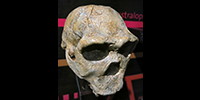
Homo habilis
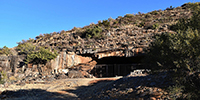 Wonderwerk Cave in South Africa contains stone tools dated to two million years ago, possibly knapped by Homo habilis. It is one of the earliest cave occupation sites in the world, and is the site of some of the earliest uses of controlled fire and tool making..
Wonderwerk Cave in South Africa contains stone tools dated to two million years ago, possibly knapped by Homo habilis. It is one of the earliest cave occupation sites in the world, and is the site of some of the earliest uses of controlled fire and tool making..
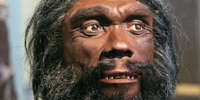 Homo heidelbergensis is an extinct species of the genus Homo which lived in Africa, Europe and western Asia from at least 600 000 years ago, and may date back 1 300 000 years. It survived until 200 000 to 250 000 years ago. It is probably the ancestor of Homo sapiens in Africa and the Neanderthals in Europe, and perhaps also the Denisovans in Asia. It was first discovered near Heidelberg in Germany in 1907 and named by Otto Schoetensack. Some experts believe that H. heidelbergensis, like its descendant H. neandertalensis, acquired a primitive form of language. No forms of art or sophisticated artefacts other than stone tools have been uncovered, although red ochre, a mineral that can be used to create a red pigment which is useful as a paint, has been found at Terra Amata excavations in the south of France.
Homo heidelbergensis is an extinct species of the genus Homo which lived in Africa, Europe and western Asia from at least 600 000 years ago, and may date back 1 300 000 years. It survived until 200 000 to 250 000 years ago. It is probably the ancestor of Homo sapiens in Africa and the Neanderthals in Europe, and perhaps also the Denisovans in Asia. It was first discovered near Heidelberg in Germany in 1907 and named by Otto Schoetensack. Some experts believe that H. heidelbergensis, like its descendant H. neandertalensis, acquired a primitive form of language. No forms of art or sophisticated artefacts other than stone tools have been uncovered, although red ochre, a mineral that can be used to create a red pigment which is useful as a paint, has been found at Terra Amata excavations in the south of France.
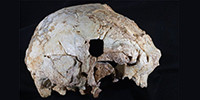 The recently found oldest fossil human cranium in Portugal marks an important contribution to the knowledge of human evolution during the middle Pleistocene in Europe and to the origin of the Neandertals. This cranium of Homo heidelbergensis represents the westernmost human fossil ever found in Europe during the middle Pleistocene epoch and one of the earliest on this continent to be associated with the Acheulean stone tool industry.
The recently found oldest fossil human cranium in Portugal marks an important contribution to the knowledge of human evolution during the middle Pleistocene in Europe and to the origin of the Neandertals. This cranium of Homo heidelbergensis represents the westernmost human fossil ever found in Europe during the middle Pleistocene epoch and one of the earliest on this continent to be associated with the Acheulean stone tool industry.
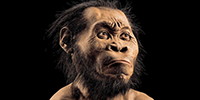
Homo naledi

Mousterian (Neanderthal) Sites
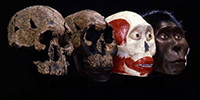
Homo rudolfensis
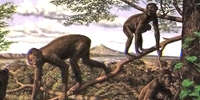 Proconsul africanus is the first species of the oligocene-era fossil genus of primate to be discovered and was named by Arthur Hopwood, an associate of Louis Leakey, in 1933. The Leakey expedition of 1947 - 1948 to Rusinga Island in Lake Victoria uncovered more species of Proconsul. Louis Leakey made an especially complete find of Proconsul there in 1948. The 18-million-year-old fossil species has been considered a possible ancestor of both great and lesser apes, and of humans. Opinion currently favours a position between the monkeys and the apes.
Proconsul africanus is the first species of the oligocene-era fossil genus of primate to be discovered and was named by Arthur Hopwood, an associate of Louis Leakey, in 1933. The Leakey expedition of 1947 - 1948 to Rusinga Island in Lake Victoria uncovered more species of Proconsul. Louis Leakey made an especially complete find of Proconsul there in 1948. The 18-million-year-old fossil species has been considered a possible ancestor of both great and lesser apes, and of humans. Opinion currently favours a position between the monkeys and the apes.
 Back to Archaeological Sites
Back to Archaeological Sites
 Back to the review of hominins
Back to the review of hominins
 Hominid sites in Africa, including Homo sapiens
Hominid sites in Africa, including Homo sapiens
 Hominid sites in Europe, including Homo sapiens
Hominid sites in Europe, including Homo sapiens




 Homo floresiensis was a one metre tall, human-like creature living and using tools in Indonesia just 18 000 years ago and was a distinct species, not just a malformed modern human. The so-called hobbit had wrist bones almost identical to those found in early hominins and modern chimpanzees, and so must have diverged from the human lineage well before modern humans and Neanderthals arose.
Homo floresiensis was a one metre tall, human-like creature living and using tools in Indonesia just 18 000 years ago and was a distinct species, not just a malformed modern human. The so-called hobbit had wrist bones almost identical to those found in early hominins and modern chimpanzees, and so must have diverged from the human lineage well before modern humans and Neanderthals arose.
 The swamp ape Oreopithecus bambolii was 120 cm tall and weighed 30 kg, with a brain capacity of up to 200 cm3 lived in swampy areas of what is now Italy, 10 to 8 million years ago. The long forelimbs are indicative of tree-dwelling. The ape went extinct after a land bridge connected their island to the mainland, allowing large saber-toothed cats and other predators to stalk the island.
The swamp ape Oreopithecus bambolii was 120 cm tall and weighed 30 kg, with a brain capacity of up to 200 cm3 lived in swampy areas of what is now Italy, 10 to 8 million years ago. The long forelimbs are indicative of tree-dwelling. The ape went extinct after a land bridge connected their island to the mainland, allowing large saber-toothed cats and other predators to stalk the island.
 Of all the ancient peoples that have been studied by scientists, none has set puzzles quite so profound as those left behind by the Denisovans. Only a few tiny pieces of bone and teeth have ever been found of this long extinct species – fragmentary remains that would all fit snugly inside a cigarette packet. Yet these fossil scraps suggest that Denisovans had a considerable influence on people today. Up to 6% of the genes now found in modern New Guineans and 3-5% of the DNA of aboriginal Australians is made up of Denisovan DNA, scientists have discovered. The gene that allows Tibetan people to survive high altitudes is also believed to have been inherited from them.
Of all the ancient peoples that have been studied by scientists, none has set puzzles quite so profound as those left behind by the Denisovans. Only a few tiny pieces of bone and teeth have ever been found of this long extinct species – fragmentary remains that would all fit snugly inside a cigarette packet. Yet these fossil scraps suggest that Denisovans had a considerable influence on people today. Up to 6% of the genes now found in modern New Guineans and 3-5% of the DNA of aboriginal Australians is made up of Denisovan DNA, scientists have discovered. The gene that allows Tibetan people to survive high altitudes is also believed to have been inherited from them.
 Australopithecus aethiopicus is in the group known as the robust australopithecines. The robust australopithecines are split into three species, Australopithecus aethiopicus, Australopithecus robustus, and Australopithecus boisei. There has been an ongoing debate over the exact phyletic origins of each of these species. The robust australopithecines share many characteristics of the cranium and mandible, perhaps suggesting a shared evolutionary development.
Australopithecus aethiopicus is in the group known as the robust australopithecines. The robust australopithecines are split into three species, Australopithecus aethiopicus, Australopithecus robustus, and Australopithecus boisei. There has been an ongoing debate over the exact phyletic origins of each of these species. The robust australopithecines share many characteristics of the cranium and mandible, perhaps suggesting a shared evolutionary development.
 Lucy, Australopithecus afarensis, is an extinct hominid that lived between 3.9 and 2.9 million years ago. Australopithecus afarensis was slenderly built, like the younger Australopithecus africanus. It is thought that Australopithecus afarensis was more closely related to the genus Homo (which includes the modern human species Homo sapiens ), whether as a direct ancestor or a close relative of an unknown ancestor, than any other known primate from the same time.
Lucy, Australopithecus afarensis, is an extinct hominid that lived between 3.9 and 2.9 million years ago. Australopithecus afarensis was slenderly built, like the younger Australopithecus africanus. It is thought that Australopithecus afarensis was more closely related to the genus Homo (which includes the modern human species Homo sapiens ), whether as a direct ancestor or a close relative of an unknown ancestor, than any other known primate from the same time. 
 Australopithecus boisei or Paranthropus boisei was an early hominin. It lived in Eastern Africa during the Pleistocene epoch from about 2.3 until about 1.2 million years ago. First discovered by anthropologist Mary Leakey in 1959, at Olduvai Gorge, Tanzania, the well-preserved cranium (nicknamed 'Nutcracker Man') was dated to 1.75 million years old and had characteristics distinctive of the robust australopithecines. The brain volume is quite small, about 500 cc, not much larger in comparison to Australopithecus afarensis and Australopithecus africanus, or modern day chimpanzees. It had a skull highly specialised for heavy chewing and several traits seen in modern day gorillas. It inhabited savannah woodland territories.
Australopithecus boisei or Paranthropus boisei was an early hominin. It lived in Eastern Africa during the Pleistocene epoch from about 2.3 until about 1.2 million years ago. First discovered by anthropologist Mary Leakey in 1959, at Olduvai Gorge, Tanzania, the well-preserved cranium (nicknamed 'Nutcracker Man') was dated to 1.75 million years old and had characteristics distinctive of the robust australopithecines. The brain volume is quite small, about 500 cc, not much larger in comparison to Australopithecus afarensis and Australopithecus africanus, or modern day chimpanzees. It had a skull highly specialised for heavy chewing and several traits seen in modern day gorillas. It inhabited savannah woodland territories.

 Several teeth from an adult and children, and the fossilised mandible of a diminutive species of early human that lived 700 000 years ago have been discovered on the Indonesian island of Flores. It is thought to be the direct ancestor of the Hobbit of Flores, the 1.1 metre tall human species that lived around 50 000 years ago.
Several teeth from an adult and children, and the fossilised mandible of a diminutive species of early human that lived 700 000 years ago have been discovered on the Indonesian island of Flores. It is thought to be the direct ancestor of the Hobbit of Flores, the 1.1 metre tall human species that lived around 50 000 years ago.

 Wonderwerk Cave in South Africa contains stone tools dated to two million years ago, possibly knapped by Homo habilis. It is one of the earliest cave occupation sites in the world, and is the site of some of the earliest uses of controlled fire and tool making..
Wonderwerk Cave in South Africa contains stone tools dated to two million years ago, possibly knapped by Homo habilis. It is one of the earliest cave occupation sites in the world, and is the site of some of the earliest uses of controlled fire and tool making.. Homo heidelbergensis is an extinct species of the genus Homo which lived in Africa, Europe and western Asia from at least 600 000 years ago, and may date back 1 300 000 years. It survived until 200 000 to 250 000 years ago. It is probably the ancestor of Homo sapiens in Africa and the Neanderthals in Europe, and perhaps also the Denisovans in Asia. It was first discovered near Heidelberg in Germany in 1907 and named by Otto Schoetensack. Some experts believe that H. heidelbergensis, like its descendant H. neandertalensis, acquired a primitive form of language. No forms of art or sophisticated artefacts other than stone tools have been uncovered, although red ochre, a mineral that can be used to create a red pigment which is useful as a paint, has been found at Terra Amata excavations in the south of France.
Homo heidelbergensis is an extinct species of the genus Homo which lived in Africa, Europe and western Asia from at least 600 000 years ago, and may date back 1 300 000 years. It survived until 200 000 to 250 000 years ago. It is probably the ancestor of Homo sapiens in Africa and the Neanderthals in Europe, and perhaps also the Denisovans in Asia. It was first discovered near Heidelberg in Germany in 1907 and named by Otto Schoetensack. Some experts believe that H. heidelbergensis, like its descendant H. neandertalensis, acquired a primitive form of language. No forms of art or sophisticated artefacts other than stone tools have been uncovered, although red ochre, a mineral that can be used to create a red pigment which is useful as a paint, has been found at Terra Amata excavations in the south of France.
 The recently found oldest fossil human cranium in Portugal marks an important contribution to the knowledge of human evolution during the middle Pleistocene in Europe and to the origin of the Neandertals. This cranium of Homo heidelbergensis represents the westernmost human fossil ever found in Europe during the middle Pleistocene epoch and one of the earliest on this continent to be associated with the Acheulean stone tool industry.
The recently found oldest fossil human cranium in Portugal marks an important contribution to the knowledge of human evolution during the middle Pleistocene in Europe and to the origin of the Neandertals. This cranium of Homo heidelbergensis represents the westernmost human fossil ever found in Europe during the middle Pleistocene epoch and one of the earliest on this continent to be associated with the Acheulean stone tool industry.


 Proconsul africanus is the first species of the oligocene-era fossil genus of primate to be discovered and was named by Arthur Hopwood, an associate of Louis Leakey, in 1933. The Leakey expedition of 1947 - 1948 to Rusinga Island in Lake Victoria uncovered more species of Proconsul. Louis Leakey made an especially complete find of Proconsul there in 1948. The 18-million-year-old fossil species has been considered a possible ancestor of both great and lesser apes, and of humans. Opinion currently favours a position between the monkeys and the apes.
Proconsul africanus is the first species of the oligocene-era fossil genus of primate to be discovered and was named by Arthur Hopwood, an associate of Louis Leakey, in 1933. The Leakey expedition of 1947 - 1948 to Rusinga Island in Lake Victoria uncovered more species of Proconsul. Louis Leakey made an especially complete find of Proconsul there in 1948. The 18-million-year-old fossil species has been considered a possible ancestor of both great and lesser apes, and of humans. Opinion currently favours a position between the monkeys and the apes.